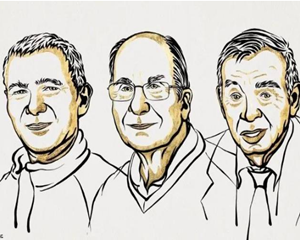The Royal Swedish Academy of Sciences announced Wednesday that two Americans and a Russian scientist jointly won this year's Nobel Prize in chemistry, for their discovery and synthesis of quantum dots.
瑞典皇家科学院本周三宣布,两名美国科学家和一名俄罗斯科学家共同获得了今年的诺贝尔化学奖,以表彰他们在发现和合成量子点方面所作出的贡献。
"The Royal Swedish Academy of Sciences has decided to award the 2023 Nobel Prize in Chemistry in equal shares to Moungi Bawendi, Massachusetts Institute of Technology (MIT), USA,
“瑞典皇家科学院决定将2023年诺贝尔化学奖授予美国麻省理工学院的蒙吉·巴文迪、
Louis Brus, Columbia University, USA, and Alexei Ekimov, Nanocrystals Technology Inc., USA, for the discovery and synthesis of quantum dots."
美国哥伦比亚大学的路易斯·布鲁斯和美国量子晶体科技公司的阿列克谢·叶基莫夫,以表彰他们发现和合成了量子点。
The three U.S.-based Nobel Prize laureates took the prize for their work with quantum dots,
这三位身在美国的诺贝尔奖获得者,是凭借在量子点方面的贡献而获奖的,
or tiny particles that are just a few atoms in diameter and whose electrons have constrained movement.
量子点是指直径只有几个原子大的微小粒子,且电子的运动受到限制

Their work showed how they absorb and release visible light, allowing for very bright colors,
三位科学家的研究呈现了量子点是如何吸收和释放可见光、从而产生非常鲜艳的颜色的,
ultimately contributing to numerous applications ranging from QLED screens to imaging in biochemistry, medicine, and much more.
并最终为众多应用--从QLED屏幕到生物化学、医学等领域的成像等等--做出贡献。
The dots emit different colors depending on their size, with larger dots shining red, and smaller dots shining blue.
量子点会根据自身大小发出不同的颜色,较大的会发出红色的光,较小的会发出蓝色的光。
The Royal Swedish Academy of Sciences also noted that the work with quantum dots will also allow for for surgeons to find tumors more precisely,
瑞典皇家科学院还指出,量子点的研究还将使外科医生能够更精确地发现肿瘤,
as the particles catalyze chemical reactions and their clear light can illuminate tumor tissue.
由于这些粒子催化了化学反应,它们发出的清晰的光线可以照亮肿瘤组织。













